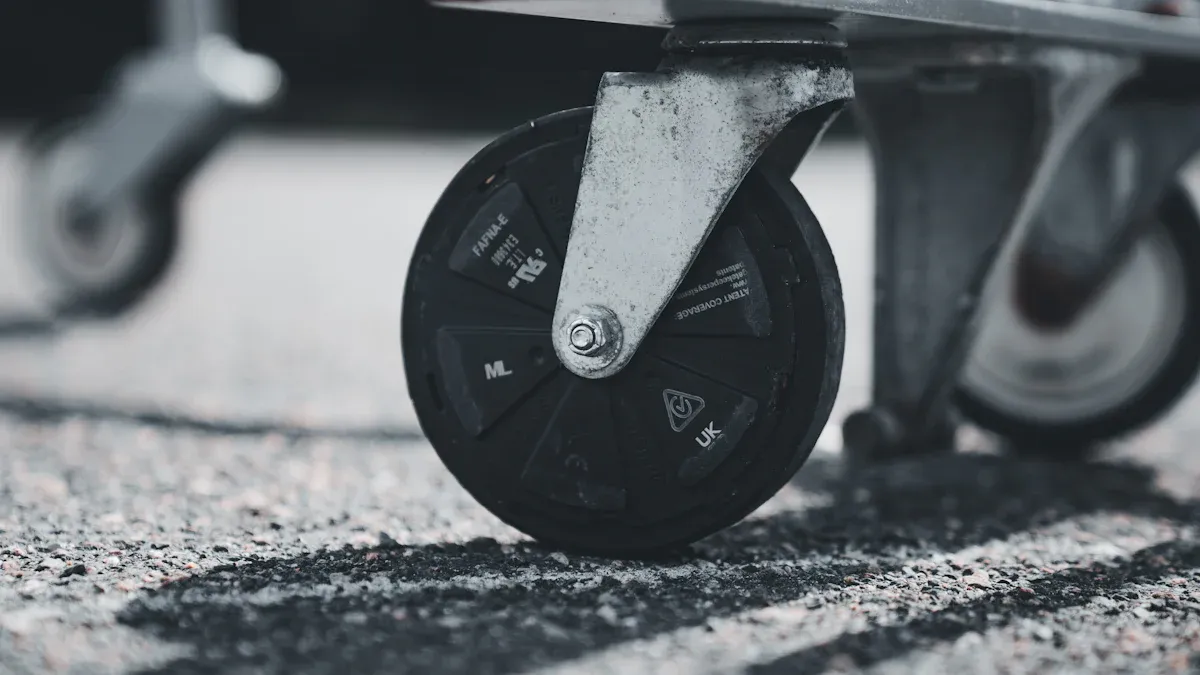Selecting the right wheels significantly impacts the performance of logistics trolleys. Proper wheel selection enhances efficiency and ensures safety during operations. Understanding load capacity is essential; it helps prevent overloading and potential accidents. Moreover, choosing the right material contributes to the durability of the wheels in various environments. For instance, polyurethane wheels offer high durability, excellent load capacity, and non-marking features, making them ideal for industrial settings.
Key Takeaways
- Selecting the right wheels enhances the efficiency and safety of logistics trolleys.
- Understanding load capacity is crucial to preventing overloading and mechanical failures.
- Larger wheels improve maneuverability over uneven surfaces and distribute weight better.
- Choosing the right wheel material, like polyurethane, increases durability and performance.
- Incorporating safety margins in load calculations helps prevent accidents and equipment failure.
- Low rolling resistance wheels reduce energy consumption, improving overall productivity.
- Regular maintenance and inspections of wheels extend their lifespan and ensure optimal performance.
- Selecting wheels based on environmental conditions protects sensitive flooring and enhances safety.
Understanding Load Capacity
Importance of Load Capacity
Load capacity plays a critical role in the performance of logistics trolleys. It determines how much weight the wheels can safely support without compromising safety or functionality. Selecting wheels with the appropriate load capacity ensures that the trolley operates efficiently and reduces the risk of mechanical failures. Overloading can lead to severe consequences, including:
- Mechanical failures due to overloaded vehicles strain components like tires, suspensions, and engines.
- Legal penalties for exceeding weight limits include fines or forced unloading.
- Increased operational costs, as noted by a 2024 Federal Highway Administration report, indicate that 15% of heavy haul violations arise from weight miscalculations, costing companies millions annually.
Calculating Load Requirements
Calculating the required load capacity for logistics trolley wheels involves a systematic approach. This guide outlines the process for determining the correct load capacity for wheels with Polyurethane (Vulkollan) tires, ensuring safe and efficient operation. Here are the steps to follow:
- Determine the total load, which is the weight of the transport equipment plus the weight of the load.
- Divide the total load by the number of load-bearing castors, subtracting one castor to account for uneven surfaces.
- Calculate the dynamic load capacity required for each caster.
Additionally, always divide the total load by three for transport equipment with four wheels or castors. Load capacity is based on standard conditions, including speed and floor type.
| Wheel Type | Total Load Capacity | Individual Wheel Capacity | Recommended Use |
|---|---|---|---|
| Light Duty | Up to 200 kg | Up to 300 kg | Tool trolleys, luggage trolleys |
| Medium Duty | Up to 500 kg | Up to 700 kg | Indoor industrial trolleys |
| Heavy Duty | Over 500 kg | Up to 4300 kg | Towed by mechanical equipment |
Safety Margins in Load Capacity
Incorporating safety margins into load capacity calculations is essential for accident prevention. It is recommended to add one-third to the weight on the casters. For example, if a cart weighs 50 pounds and carries 250 pounds, the total wheel caster rating should be 400 pounds, which includes a safety margin of 100 pounds.
Safety margins help prevent exceeding the rated capacity of casters. This reduction in load risk minimizes the chances of equipment failure and lowers the risk of workplace injuries through proper load management. By ensuring that logistics trolleys operate within safe limits, businesses can enhance operational efficiency and maintain a safer working environment.
Choosing the Right Wheels: Diameter and Material

Selecting the right wheels involves considering both diameter and material. These factors significantly influence the performance and suitability of logistics trolleys for various applications.
Impact of Wheel Diameter
Wheel diameter affects maneuverability and load distribution. Larger wheels enhance mobility over uneven surfaces and improve load capacity by distributing weight more evenly. They are particularly beneficial in industrial settings where rough terrains are common. Here are some key points regarding wheel diameter:
- Larger Wheels:
- Smoothly roll over obstacles, making them suitable for uneven surfaces.
- Provide greater clearance and absorb shocks effectively.
- Better suited for heavy loads and rough terrains.
- Smaller Wheels:
- Offer agility on smooth surfaces, allowing for precise movements.
- Struggle with obstacles, making them less effective on uneven ground.
The following table outlines common wheel diameters used in logistics trolleys along with their typical applications and load capacities:
| Wheel Diameter | Typical Application | Load Capacity |
|---|---|---|
| 200mm | Warehouse carts for heavy pallets | Up to 500kg |
| 125mm | Hospital equipment | Frequent movement |
| 75mm | Light-duty retail trolleys | Up to 100kg |
| 50-75mm | Small office chairs or furniture | Light loads |
Common Wheel Materials
The choice of wheel material directly impacts durability, maintenance, and performance. Different materials offer distinct advantages, making them suitable for various environments. The following table summarizes the most widely used materials for logistics trolley wheels:
| Material | Advantages |
|---|---|
| Polyamide (PA) | Cost-effective, high load capacity, strong, and low rolling resistance. |
| Polypropylene (PP) | Affordable, high load capacity, and strong. |
| Polyurethane (PU) | Ideal for mixed indoor/outdoor use, sound absorbent, does not damage floors, and absorbs vibrations. |
| Rubber | Flexible, shock-absorbing, sound-absorbing, and provides better grip on rough terrain. |
Choosing the Right Material for Your Environment
Selecting the right material for wheels depends on the specific environmental conditions they will face. For instance, polyurethane wheels are highly resistant to chemicals, oils, and solvents, making them suitable for wet and oily environments. Additionally, they provide excellent load-bearing capacity and impact resistance. Here are some considerations when choosing wheel materials:
- Floor Type: Softer materials like polyurethane protect sensitive surfaces, while harder materials may cause damage.
- Chemical Resistance: Polyurethane withstands exposure to chemicals, oils, and solvents, making it ideal for industrial applications.
- Temperature Resistance: Polyurethane maintains performance in extreme temperatures, ensuring reliability in various environments.
Regular maintenance is crucial for all wheel types. Users should monitor load capacity to prevent premature wear, clean the casters regularly to avoid dirt accumulation, and inspect the swivel joint for signs of wear. By selecting the right wheels based on diameter and material, businesses can enhance the efficiency and safety of their logistics operations.
Rolling Resistance and the Right Wheels
Definition of Rolling Resistance
Rolling resistance, also known as rolling friction or rolling drag, refers to the force that opposes the motion of a body, such as a wheel, as it rolls on a surface. This resistance primarily arises from non-elastic effects. When a wheel deforms under load, not all the energy used for this deformation is recovered when the pressure is released. This energy loss can significantly impact the efficiency of logistics operations.
Factors Affecting Rolling Resistance
Several factors influence rolling resistance in logistics trolley wheels. Understanding these factors helps in selecting the right wheels for specific applications. Key factors include:
- Castor Wheel Material: Different materials, such as rubber, nylon, and polyurethane, exhibit varying levels of resistance.
- Castor Wheel Size: Larger wheels generally experience lower rolling resistance compared to smaller ones.
- Flooring Substrate: The type of flooring, whether concrete, carpet, or tiles, affects how wheels interact with the surface.
- Flooring Condition: Level surfaces reduce resistance, while uneven or uphill surfaces increase it.
- Castor Wheel Bearings: The type of bearings used, such as plain, ball, or roller bearings, can impact the ease of movement.
- Inertia: The resistance to movement based on the equipment’s dimensions plays a role in rolling resistance.
- Total Weight of the Equipment: Heavier loads increase the force required to move the trolley, thus increasing rolling resistance.
The material and size of the castor wheels, along with the type and condition of the flooring, significantly influence rolling resistance. Softer treads compress more under load, leading to higher resistance, while harder treads experience less compression, resulting in lower resistance on smooth surfaces.
Benefits of Low Rolling Resistance Wheels
Low rolling resistance wheels are specifically engineered to decrease the energy needed for movement. This reduction in energy consumption is crucial for Automated Guided Vehicles (AGVs) and Autonomous Mobile Robots (AMRs). These vehicles can function longer on a single charge, leading to fewer recharging sessions. This not only cuts down on energy costs but also enhances overall productivity by minimizing operational downtime.
By selecting wheels with low rolling resistance, businesses can improve their logistics efficiency. These wheels allow for smoother operations, reduce wear on equipment, and contribute to a safer working environment. Ultimately, choosing the right wheels can lead to significant cost savings and improved performance in logistics operations.
Cushioning and Shock Absorption
Importance of Cushioning
Cushioning plays a vital role in the performance of logistics trolleys. It helps absorb shocks and vibrations during movement, which protects both the trolley and its cargo. Proper cushioning reduces wear and tear on the wheels and the trolley frame, extending their lifespan. Additionally, effective cushioning minimizes noise, creating a more pleasant working environment.
Types of Cushioning Materials
Several materials provide effective cushioning for logistics trolley wheels. Each material offers unique benefits, making them suitable for different applications. Here are some of the most effective cushioning materials:
- Pneumatic Wheels: These wheels contain air-filled tires that cushion bumps and absorb shocks effectively. They are particularly useful in environments with uneven surfaces.
- Rubber Wheels: Rubber provides a softer ride and better grip, making it ideal for outdoor surfaces that may be uneven or rough.
- Spring Loaded Casters: These casters feature a heavy-duty, spring-loaded design that enhances shock absorption. They are particularly effective on uneven terrain, providing a cushioned ride.
RWM Casters manufactures shock-absorbing casters designed to traverse uneven terrain, ensuring a smooth experience for users. The combination of pneumatic and spring-loaded designs makes these wheels excellent choices for logistics operations.
Evaluating Shock Absorption Needs
Evaluating shock absorption needs is crucial for selecting the right wheels for logistics trolleys, especially in rough terrain environments. The following table outlines various wheel types, their shock absorption capabilities, and their best uses:
| Wheel Type | Shock Absorption | Best Use |
|---|---|---|
| Pneumatic | Excellent | Construction sites and outdoor factories |
| Rubber | Good | Uneven outdoor surfaces |
When assessing shock absorption needs, consider the following factors:
- Surface Conditions: Identify the types of surfaces the trolley will traverse. Uneven surfaces require wheels with superior shock absorption.
- Load Weight: Heavier loads may necessitate wheels with enhanced cushioning properties to prevent damage during transport.
- Operational Environment: Environments with frequent bumps or vibrations benefit from wheels designed to absorb shocks effectively.
By carefully evaluating these factors, businesses can select the most suitable wheels for their logistics trolleys, ensuring optimal performance and safety during operations.
Wear Resistance in the Right Wheels

Understanding Wear Resistance
Wear resistance refers to a wheel’s ability to withstand degradation over time due to friction and contact with surfaces. Selecting wheels with high wear resistance is crucial for logistics trolleys, especially in environments with heavy usage. Wheels that wear down quickly can lead to increased maintenance costs and operational inefficiencies. Therefore, businesses must prioritize wear resistance when choosing the right wheels for their logistics operations.
Indicators of Wheel Wear
Identifying signs of wheel wear is essential for maintaining optimal performance. Here are key indicators to monitor:
| Indicator | Description |
|---|---|
| Operating noisily or swaying | Indicates potential wear or damage to wheels. |
| Trouble pushing or maneuvering cart | Suggests degradation in wheel performance. |
| Visible cracks or flat areas | Direct evidence of physical damage to wheels. |
| Enhanced resilience to rolling | May indicate wear affecting rolling efficiency. |
| Not smoothly turning swivel wheels | Points to issues with wheel functionality. |
Regular inspections can help detect these indicators early. Additionally, operators should check for flat spots due to prolonged static loading and tighten mounting bolts to prevent loosening from vibrations.
Selecting Wheels for High-Wear Environments
Choosing the right wheels for high-wear environments requires careful consideration of materials and design. Polyurethane wheels stand out for their excellent durability and wear resistance. They can support heavy loads while absorbing shocks, making them ideal for warehousing and logistics, especially on polished concrete floors.
Here are some benefits of using polyurethane wheels:
- Superior Strength: Polyurethane wheels resist cuts and tears, making them suitable for environments with debris or rough flooring.
- Longevity: These wheels maintain their performance over extended periods, reducing the need for frequent replacements.
By selecting wheels designed for high-wear applications, businesses can enhance their logistics operations. This choice minimizes downtime and maintenance costs, ensuring smooth and efficient transport of goods.
Ground Protection with the Right Wheels
Importance of Ground Protection
Ground protection is essential in logistics operations, especially when dealing with sensitive flooring. The right wheels can prevent damage to surfaces, ensuring that facilities maintain their aesthetic appeal and functionality. Protecting floors reduces maintenance costs and prolongs the lifespan of the flooring material. Logistics managers must prioritize wheel selection to minimize the risk of scratches, dents, and other forms of damage.
Wheel Types for Sensitive Surfaces
Choosing the appropriate wheels for sensitive surfaces can significantly impact ground protection. Here are some recommended wheel types:
- Elastic Rubber Wheels: These wheels excel in shock absorption and noise reduction, making them ideal for sensitive flooring. Their cushioning properties help minimize impact during movement.
- Solid Rubber Wheels: Designed specifically to protect delicate floors, solid rubber wheels provide excellent shock absorption. They feature a non-marking surface that prevents scuffs and stains, making them suitable for environments like hospitals and retail spaces.
- Polyurethane Wheels: Known for their durability, polyurethane wheels can handle heavy loads while offering floor protection. They resist harsh conditions and provide a balance between strength and surface safety.
By selecting the right wheel type, businesses can ensure that their logistics operations do not compromise the integrity of their flooring.
Evaluating Ground Impact
Evaluating the ground impact of logistics trolley wheels is crucial for optimizing performance and protecting surfaces. Here are some key factors to consider:
- Load Distribution: Properly distributing the load across multiple wheels reduces stress on each wheel. This minimizes friction and resistance, facilitating smoother movement.
- Friction: The resistance between the wheels and the ground affects the effort needed to move loads. Reducing friction through careful material selection and regular maintenance enhances efficiency.
- Wheel Material: The choice of wheel material impacts rolling resistance and durability. For instance, polyurethane wheels are effective for minimizing push-pull force due to their low rolling resistance.
By focusing on these factors, logistics managers can effectively evaluate and minimize ground impact. This approach not only protects sensitive surfaces but also enhances overall operational efficiency.
Temperature Resistance and the Right Wheels
Temperature resistance is a critical factor when selecting wheels for logistics trolleys. Extreme temperatures can significantly affect wheel performance, leading to potential failures or inefficiencies. Understanding how temperature impacts wheels helps businesses make informed decisions.
Effects of Temperature on Wheel Performance
Temperature fluctuations can alter the physical properties of wheel materials. For instance, high temperatures may cause certain materials to soften, leading to deformation under load. Conversely, low temperatures can make materials brittle, increasing the risk of cracking.
- High Temperatures: Wheels made from materials like polyurethane may lose their structural integrity, resulting in reduced load capacity.
- Low Temperatures: Materials such as rubber can become stiff, leading to increased rolling resistance and difficulty in maneuverability.
To illustrate the temperature tolerance of various wheel materials, consider the following table:
| Material | Operating Temperature (°F) | Characteristics |
|---|---|---|
| Glass-Filled Nylon | Up to 490° continuous | Resilient, non-marking, durable, resistant to oils and greases. |
| Hard Rubber | -40° to 180° intermittent | High load capacity, easy rolling, resistant to chemicals and solvents. |
| Phenolic Resin | -50° to 250° | Hard, oil-resistant, suitable for push/pull applications. |
| High Temp Phenolic | -50° to 550° | Durable, shock load resistant, non-marking, suitable for dry heat applications. |
| Cast Iron | Up to 600° | Suitable for high-temperature applications. |
| Forged Steel | Up to 600° | High-strength, suitable for extreme heat. |
| Solid Elastomer | -40°F | Smooth rolling, resistant to cold, does not develop flat spots. |
| Polyurethane | -40°F | Durable, cold-resistant, suitable for freezers. |
| Nylon | -40°F | Lightweight, moisture-resistant, low rolling resistance. |
Selecting Temperature-Resistant Wheels
When selecting wheels for extreme temperatures, businesses should prioritize materials that maintain performance under specific conditions. For example, solid elastomer casters perform well in cold environments, while polyurethane casters are ideal for freezer applications.
- Solid Elastomer Casters: Highly resistant to cold, ensuring smooth rolling performance even in -40°F temperatures.
- Polyurethane Casters: Excellent for freezers, providing durability and cold resistance.
- Nylon Casters: Moisture-resistant, commonly used in food storage and outdoor logistics.
Applications in Extreme Conditions
Certain industries require wheels that can withstand extreme temperatures. Here are some examples:
| Application Area | Temperature Range | Description |
|---|---|---|
| Industrial Production Lines | 80-120°C | Used in high-temperature drying sections of automotive paint shops and electronic component reflow soldering lines. |
| Food Processing | 90-130°C | Employed in bakery tray transfer carts and pharmaceutical freeze-drying workshops, meeting hygiene standards. |
| Warehousing and Logistics | 80-100°C | Utilized in glassware and semi-finished rubber warehouses, ensuring stable transport under high temperatures. |
By understanding the effects of temperature on wheel performance and selecting appropriate materials, businesses can enhance the reliability and efficiency of their logistics operations. Proper wheel selection not only improves safety but also extends the lifespan of equipment in challenging environments.
Types of Wheels: Choosing the Right Wheels
Fixed vs. Swivel Wheels
When selecting wheels for logistics trolleys, understanding the differences between fixed and swivel wheels is essential. Fixed casters provide excellent stability and control in straight-line movements. They are ideal for heavy-duty applications that require precise movement. Swivel casters, on the other hand, offer superior maneuverability, allowing for easy directional changes in confined spaces.
| Feature | Fixed Casters | Swivel Casters |
|---|---|---|
| Maneuverability | Excellent stability and straight-line control | Superior maneuverability, easy directional changes |
| Ideal Use | Heavy-duty applications requiring precise movement | Navigation in confined spaces |
| Load Capacity | Generally higher load capacity | Lower load capacity compared to fixed |
| Durability | More durable due to simpler construction | Less durable due to complex design |
Bearing Types and the Right Wheels
Importance of Bearings in Wheel Performance
Bearings play a crucial role in the performance of logistics trolley wheels. They facilitate smooth rotation, which is essential for efficient operation in a logistics environment. The type of caster bearing selected directly influences how well the wheels swivel and roll. This impact extends to the overall maneuverability of the trolley, affecting its ability to navigate tight spaces and uneven surfaces.
Choosing the right bearing type enhances load capacity and reduces maintenance needs. Properly selected bearings minimize friction, which not only allows for smoother movement but also prolongs the lifespan of both the wheels and the equipment. Therefore, understanding the importance of bearings is vital for optimizing logistics operations.
Common Bearing Types
Several common bearing types are available for logistics trolley wheels, each with distinct characteristics. Here are the most frequently used types:
- Plain Bearings: These are simple and cost-effective. They consist of a sliding surface that allows for basic movement. However, they may require more frequent maintenance due to higher friction levels.
- Ball Bearings: These bearings use balls to reduce friction between moving parts. They provide excellent performance and durability, making them suitable for heavy loads and high-speed applications.
- Roller Bearings: Roller bearings utilize cylindrical rollers instead of balls. They can handle heavier loads and are often used in industrial settings where durability is essential.
- Needle Bearings: These are a type of roller bearing with long, thin rollers. They are ideal for applications with limited space and can support high radial loads.
Each bearing type has its advantages and disadvantages. The choice depends on the specific requirements of the logistics trolley, including load capacity, speed, and environmental conditions.
Choosing the Right Bearing for Your Needs
Selecting the appropriate bearing for logistics trolley wheels requires careful consideration of several factors. First, assess the load capacity needed for the specific application. For instance, ball bearings may be ideal for high-load scenarios, while plain bearings might suffice for lighter applications.
Next, consider the operational environment. Bearings exposed to corrosive materials or extreme temperatures require special attention. The longevity of caster bearings is influenced by their usage and the specific type selected. Choosing the right bearing enhances maneuverability and impacts how well the wheels perform under various conditions.
Selecting the right wheels for logistics trolleys is crucial for enhancing performance and safety. Informed choices lead to improved operational efficiency, reducing downtime and maintenance costs.
Tip: Before making a decision, assess specific needs based on load capacity, environment, and intended use. This careful evaluation ensures that businesses choose wheels that best fit their operational requirements.
By prioritizing these factors, companies can optimize their logistics operations and create a safer working environment.
FAQ
What factors should I consider when choosing wheels for my logistics trolley?
Consider load capacity, wheel diameter, material, rolling resistance, cushioning, wear resistance, ground protection, and temperature resistance. Each factor impacts performance and safety in different environments.
How do I determine the load capacity needed for my wheels?
Calculate the total load by adding the weight of the trolley and its cargo. Divide this total by the number of load-bearing wheels, accounting for uneven surfaces to ensure safety.
What is the difference between fixed and swivel wheels?
Fixed wheels provide stability and control for straight-line movement. Swivel wheels offer superior maneuverability, allowing for easy directional changes in tight spaces, making them suitable for different applications.
Why is rolling resistance important in wheel selection?
Rolling resistance affects the energy required to move the trolley. Lower rolling resistance wheels enhance efficiency, reduce wear on equipment, and improve overall productivity in logistics operations.
How can I assess the wear resistance of wheels?
Monitor indicators such as noise during operation, difficulty in maneuvering, visible cracks, and uneven wear. Regular inspections help identify wear early, ensuring optimal performance and safety.
What materials are best for temperature-resistant wheels?
Polyurethane and solid elastomer wheels perform well in extreme temperatures. They maintain structural integrity and functionality, making them suitable for environments with significant temperature fluctuations.
How often should I inspect my logistics trolley wheels?
Inspect wheels regularly, ideally every month or after heavy use. Check for signs of wear, damage, and proper functioning to ensure safety and efficiency in operations.
Can I use the same wheels for indoor and outdoor applications?
While some wheels can serve both environments, it is best to choose materials designed for specific conditions. Polyurethane wheels often work well for mixed-use, providing durability and floor protection.

